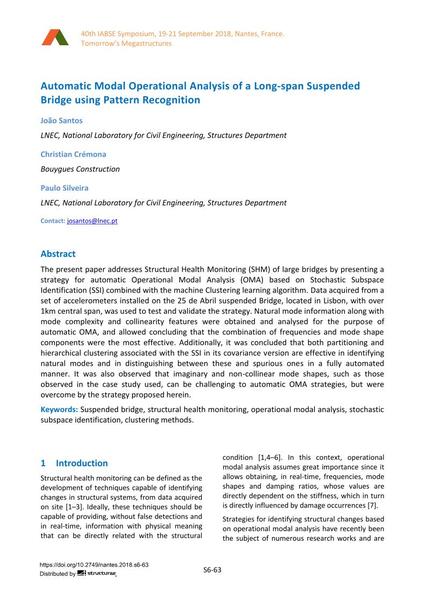Automatic Modal Operational Analysis of a Long-span Suspended Bridge using Pattern Recognition

|
|
|||||||||||
Détails bibliographiques
| Auteur(s): |
Joao Santos
(LNEC, National Laboratory for Civil Engineering, Structures Department)
Christian Crémona (Bouygues Construction) Paulo Silveira (LNEC, National Laboratory for Civil Engineering, Structures Department) |
||||
|---|---|---|---|---|---|
| Médium: | papier de conférence | ||||
| Langue(s): | anglais | ||||
| Conférence: | IABSE Symposium: Tomorrow’s Megastructures, Nantes, France, 19-21 September 2018 | ||||
| Publié dans: | IABSE Symposium Nantes 2018 | ||||
|
|||||
| Page(s): | S6-63 | ||||
| Nombre total de pages (du PDF): | 8 | ||||
| DOI: | 10.2749/nantes.2018.s6-63 | ||||
| Abstrait: |
The present paper addresses Structural Health Monitoring (SHM) of large bridges by presenting a strategy for automatic Operational Modal Analysis (OMA) based on Stochastic Subspace Identification (SSI) combined with the machine Clustering learning algorithm. Data acquired from a set of accelerometers installed on the 25 de Abril suspended Bridge, located in Lisbon, with over 1km central span, was used to test and validate the strategy. Natural mode information along with mode complexity and collinearity features were obtained and analysed for the purpose of automatic OMA, and allowed concluding that the combination of frequencies and mode shape components were the most effective. Additionally, it was concluded that both partitioning and hierarchical clustering associated with the SSI in its covariance version are effective in identifying natural modes and in distinguishing between these and spurious ones in a fully automated manner. It was also observed that imaginary and non-collinear mode shapes, such as those observed in the case study used, can be challenging to automatic OMA strategies, but were overcome by the strategy proposed herein. |
||||
